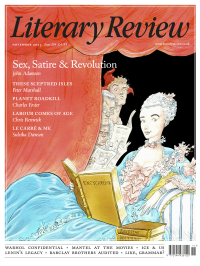Peter Moore
Freeze Frames
A Cold Spell: A Human History of Ice
By Max Leonard
Bloomsbury 320pp £20
Not so very long ago, the good readers of Literary Review could expect to be reacquainted with ice at about the time that the November issue arrived. This year, however, don’t be so sure. According to NASA, July was the hottest month since records began in 1880. Thereafter September delivered seven days of thirty-degree heat in the UK. Long into October, the smell of barbecued meat continued to waft over the garden fences of west London. The prospect of ice seems (do forgive me) increasingly thin on the ground.
A Cold Spell appears when even the most boneheaded climate sceptics are conceding that something is up. Max Leonard, naturally, engages with this. Climate change provides a political dimension, but the book is about far more than that. Leonard explains that his genesis moment came one summer’s day when he was sitting alone with a drink in a pub in Newcastle. A TV news reporter was explaining how another glacier was collapsing in the Arctic. But just as provocative for Leonard were the cubes of ice in his glass. ‘I thought’, he reflects, ‘how can we be asked to care about this remarkable thing so much in some contexts and not even notice it when we encounter it, every day, in the ordinary business of our lives?’
It is this observation that propels Leonard’s brightly written, nimbly researched and really quite delightful book off on its way. His story is arranged chronologically, starting in prehistory with the earliest interactions between Homo sapiens and ice before cantering on through the millennia to reach the Anthropocene of

Sign Up to our newsletter
Receive free articles, highlights from the archive, news, details of prizes, and much more.@Lit_Review
Follow Literary Review on Twitter
Twitter Feed
The era of dollar dominance might be coming to an end. But if not the dollar, which currency will be the backbone of the global economic system?
@HowardJDavies weighs up the alternatives.
Howard Davies - Greenbacks Down, First Editions Up
Howard Davies: Greenbacks Down, First Editions Up - Our Dollar, Your Problem: An Insider’s View of Seven Turbulent...
literaryreview.co.uk
Johannes Gutenberg cut corners at every turn when putting together his bible. How, then, did his creation achieve such renown?
@JosephHone_ investigates.
Joseph Hone - Start the Presses!
Joseph Hone: Start the Presses! - Johannes Gutenberg: A Biography in Books by Eric Marshall White
literaryreview.co.uk
Convinced of her own brilliance, Gertrude Stein wished to be ‘as popular as Gilbert and Sullivan’ and laboured tirelessly to ensure that her celebrity would outlive her.
@sophieolive examines the real Stein.
Sophie Oliver - The Once & Future Genius
Sophie Oliver: The Once & Future Genius - Gertrude Stein: An Afterlife by Francesca Wade
literaryreview.co.uk